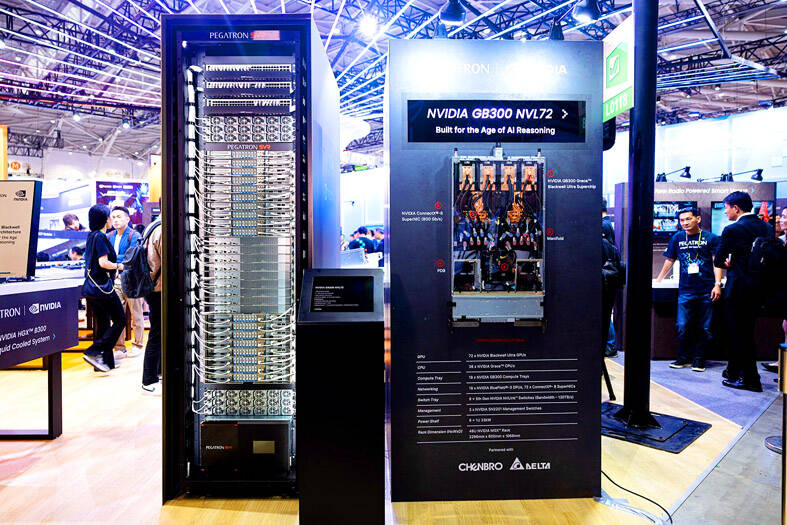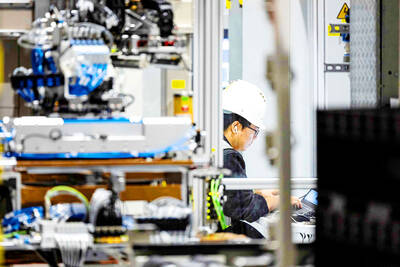Dynapack International Technology Corp (順達), which makes lithium battery packs used in notebook computers and backup battery units (BBU) for servers powered by Nvidia Corp chips, yesterday cut its revenue forecast to an annual decline of up to 20 percent, attributable to adverse impact from strong appreciation of the New Taiwan dollar and price competition.
Three months ago, the company estimated revenue this year would slide about 10 percent from NT$13.91 billion (US$472.2 million) last year, due to an intensifying pricing war for the lithium battery packs used in notebook computers.
Recent appreciation of the NT dollar against the US dollar added to the already weak information-technology (IT) sector revenue and ate into the gross margin of those products, company president Chang Chung-hsing (張崇興) told investors.

Photo: Annabelle Chih, Bloomberg
Considering the foreign exchange fluctuations, Dynapack now expects revenue to shrink at a deeper rate of between 15 and 20 percent annually, Chang said.
However, non-IT sector revenue, mostly from BBUs, would continue to grow, Chang added.
The company stuck to its original estimate of 100 percent annual growth to reach NT$1.5 billion this year, as it seeks to supply its BBU to new customers and for new artificial intelligence server racks, Chang said.
“We are optimistic about the BBU business,” Chang said.
“The adoption of BBU by data center operations is gaining traction amid concern of data loss,” he said.
BBUs are integrated with server racks, providing rapid failover protection and becoming essential for uninterrupted operations for data centers.
Overall, non-IT business is expected to make up about 30 to 40 percent of the company’s total revenue this year, while IT business would account for 60 to 70 percent, Chang said.
Dynapack also said that it is expanding BBU capacity in Taiwan and Thailand.
With rising revenue contribution from BBUs, Dynapack expects gross margin in the second half to bounce back to more than the 15 percent registered in the first quarter this year, surpassing the first half, as BBUs deliver much higher margins than the corporate average.
Gross margin improved to 14.36 percent from 11.6 percent, thanks to favorable product products and a bigger revenue share of non-IT products, the company said.
Net profit plunged 53 percent year-on-year to NT$757 million during the first two quarters of this year, compared with NT$1.56 billion in the same period last year, it said.
The year-on-year reduction was due to lack of a significant asset disposal gains in the first half of last year, company spokesperson Lin Yu-Huei (林郁蕙) told investors.
Earnings per share (EPS) dipped to NT$4.96 from NT$10.31.
Despite lower EPS in the first two quarters, Lin assured investors that the company aims to pay more than NT$10 in its cash dividend next year, as asset disposal gains would be included in the payment.

CHIP RACE: Three years of overbroad export controls drove foreign competitors to pursue their own AI chips, and ‘cost US taxpayers billions of dollars,’ Nvidia said China has figured out the US strategy for allowing it to buy Nvidia Corp’s H200s and is rejecting the artificial intelligence (AI) chip in favor of domestically developed semiconductors, White House AI adviser David Sacks said, citing news reports. US President Donald Trump on Monday said that he would allow shipments of Nvidia’s H200 chips to China, part of an administration effort backed by Sacks to challenge Chinese tech champions such as Huawei Technologies Co (華為) by bringing US competition to their home market. On Friday, Sacks signaled that he was uncertain about whether that approach would work. “They’re rejecting our chips,” Sacks

NATIONAL SECURITY: Intel’s testing of ACM tools despite US government control ‘highlights egregious gaps in US technology protection policies,’ a former official said Chipmaker Intel Corp has tested chipmaking tools this year from a toolmaker with deep roots in China and two overseas units that were targeted by US sanctions, according to two sources with direct knowledge of the matter. Intel, which fended off calls for its CEO’s resignation from US President Donald Trump in August over his alleged ties to China, got the tools from ACM Research Inc, a Fremont, California-based producer of chipmaking equipment. Two of ACM’s units, based in Shanghai and South Korea, were among a number of firms barred last year from receiving US technology over claims they have

It is challenging to build infrastructure in much of Europe. Constrained budgets and polarized politics tend to undermine long-term projects, forcing officials to react to emergencies rather than plan for the future. Not in Austria. Today, the country is to officially open its Koralmbahn tunnel, the 5.9 billion euro (US$6.9 billion) centerpiece of a groundbreaking new railway that will eventually run from Poland’s Baltic coast to the Adriatic Sea, transforming travel within Austria and positioning the Alpine nation at the forefront of logistics in Europe. “It is Austria’s biggest socio-economic experiment in over a century,” said Eric Kirschner, an economist at Graz-based Joanneum

France is developing domestic production of electric vehicle (EV) batteries with an eye on industrial independence, but Asian experts are proving key in launching operations. In the Verkor factory outside the northern city of Dunkirk, which was inaugurated on Thursday, foreign specialists, notably from South Korea and Malaysia, are training the local staff. Verkor is the third battery gigafactory to open in northern France in a region that has become known as “Battery Valley.” At the Automotive Energy Supply Corp (AESC) factory near the city of Douai, where production has been under way for several months, Chinese engineers and technicians supervise French recruits. “They